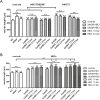Effect of hyperbaric oxygen on BDNF-release and neuroprotection: Investigations with human mesenchymal stem cells and genetically modified NIH3T3 fibroblasts as putative cell therapeutics
- PMID: 28542481
- PMCID: PMC5441643
- DOI: 10.1371/journal.pone.0178182
Effect of hyperbaric oxygen on BDNF-release and neuroprotection: Investigations with human mesenchymal stem cells and genetically modified NIH3T3 fibroblasts as putative cell therapeutics
Abstract
Hyperbaric oxygen therapy (HBOT) is a noninvasive widely applied treatment that increases the oxygen pressure in tissues. In cochlear implant (CI) research, intracochlear application of neurotrophic factors (NTFs) is able to improve survival of spiral ganglion neurons (SGN) after deafness. Cell-based delivery of NTFs such as brain-derived neurotrophic factor (BDNF) may be realized by cell-coating of the surface of the CI electrode. Human mesenchymal stem cells (MSC) secrete a variety of different neurotrophic factors and may be used for the development of a biohybrid electrode in order to release endogenously-derived neuroprotective factors for the protection of residual SGN and for a guided outgrowth of dendrites in the direction of the CI electrode. HBOT could be used to influence cell behaviour after transplantation to the inner ear. The aim of this study was to investigate the effect of HBOT on the proliferation, BDNF-release and secretion of neuroprotective factors. Thus, model cells (an immortalized fibroblast cell line (NIH3T3)-native and genetically modified) and MSCs were repeatedly (3 x - 10 x) exposed to 100% oxygen at different pressures. The effects of HBO on cell proliferation were investigated in relation to normoxic and normobaric conditions (NOR). Moreover, the neuroprotective and neuroregenerative effects of HBO-treated cells were analysed by cultivation of SGN in conditioned medium. Both, the genetically modified NIH3T3/BDNF and native NIH3T3 fibroblasts, showed a highly significant increased proliferation after five days of HBOT in comparison to normoxic controls. By contrast, the number of MSCs was decreased in MSCs treated with 2.0 bar of HBO. Treating SGN cultures with supernatants of fibroblasts and MSCs significantly increased the survival rate of SGN. HBO treatment did not influence (increase / reduce) this effect. Secretome analysis showed that HBO treatment altered the protein expression pattern in MSCs.
Conflict of interest statement
Figures





Similar articles
-
Stable release of BDNF from the fibroblast cell line NIH3T3 grown on silicone elastomers enhances survival of spiral ganglion cells in vitro and in vivo.Hear Res. 2012 Jul;289(1-2):86-97. doi: 10.1016/j.heares.2012.04.007. Epub 2012 Apr 28. Hear Res. 2012. PMID: 22564255
-
Human bone marrow-derived mesenchymal stem cells secrete brain-derived neurotrophic factor which promotes neuronal survival in vitro.Stem Cell Res. 2009 Jul;3(1):63-70. doi: 10.1016/j.scr.2009.02.006. Epub 2009 Mar 27. Stem Cell Res. 2009. PMID: 19411199
-
Long-term delivery of brain-derived neurotrophic factor (BDNF) from nanoporous silica nanoparticles improves the survival of spiral ganglion neurons in vitro.PLoS One. 2018 Mar 27;13(3):e0194778. doi: 10.1371/journal.pone.0194778. eCollection 2018. PLoS One. 2018. PMID: 29584754 Free PMC article.
-
Dental Mesenchymal Stem Cell Secretome: An Intriguing Approach for Neuroprotection and Neuroregeneration.Int J Mol Sci. 2021 Dec 31;23(1):456. doi: 10.3390/ijms23010456. Int J Mol Sci. 2021. PMID: 35008878 Free PMC article. Review.
-
Mesenchymal Stem Cell-Induced Neuroprotection in Pediatric Neurological Diseases: Recent Update of Underlying Mechanisms and Clinical Utility.Appl Biochem Biotechnol. 2024 Sep;196(9):5843-5858. doi: 10.1007/s12010-023-04752-y. Epub 2024 Jan 23. Appl Biochem Biotechnol. 2024. PMID: 38261236 Review.
Cited by
-
Early Hyperbaric Oxygen Treatment Attenuates Burn-Induced Neuroinflammation by Inhibiting the Galectin-3-Dependent Toll-Like Receptor-4 Pathway in a Rat Model.Int J Mol Sci. 2018 Jul 27;19(8):2195. doi: 10.3390/ijms19082195. Int J Mol Sci. 2018. PMID: 30060489 Free PMC article.
-
An Extra Breath of Fresh Air: Hyperbaric Oxygenation as a Stroke Therapeutic.Biomolecules. 2020 Sep 4;10(9):1279. doi: 10.3390/biom10091279. Biomolecules. 2020. PMID: 32899709 Free PMC article. Review.
-
Hyperbaric oxygen therapy as a neuromodulatory technique: a review of the recent evidence.Front Neurol. 2024 Oct 9;15:1450134. doi: 10.3389/fneur.2024.1450134. eCollection 2024. Front Neurol. 2024. PMID: 39445195 Free PMC article. Review.
-
PLLA Coating of Active Implants for Dual Drug Release.Molecules. 2022 Feb 19;27(4):1417. doi: 10.3390/molecules27041417. Molecules. 2022. PMID: 35209205 Free PMC article.
-
A Dual Role for Hyperbaric Oxygen in Stroke Neuroprotection: Preconditioning of the Brain and Stem Cells.Cond Med. 2018 Jun;1(4):151-166. Cond Med. 2018. PMID: 30079404 Free PMC article.
References
-
- Pirvola U, Hallböök F, Xing-Qun L, Virkkala J, Saarma M, Ylikoski J. Expression of neurotrophins and Trk receptors in the developing, adult, and regenerating avian cochlea. J Neurobiol. 1997;33: 1019–1033. - PubMed
-
- Flores-Otero J, Davis RL. Synaptic proteins are tonotopically graded in postnatal and adult type I and type II spiral ganglion neurons. J Comp Neurol. 2011;519: 1455–1475. doi: 10.1002/cne.22576 - DOI - PMC - PubMed
-
- Bailey EM, Green SH. Postnatal Expression of Neurotrophic Factors Accessible to Spiral Ganglion Neurons in the Auditory System of Adult Hearing and Deafened Rats. J Neurosci. 2014;34: 13110–13126. doi: 10.1523/JNEUROSCI.1014-14.2014 - DOI - PMC - PubMed
-
- Mellado Lagarde MM, Cox BC, Fang J, Taylor R, Forge A, Zuo J. Selective Ablation of Pillar and Deiters’ Cells Severely Affects Cochlear Postnatal Development and Hearing in Mice. J Neurosci. 2013;33: 1564–1576. doi: 10.1523/JNEUROSCI.3088-12.2013 - DOI - PMC - PubMed
MeSH terms
Substances
LinkOut - more resources
Full Text Sources
Other Literature Sources

